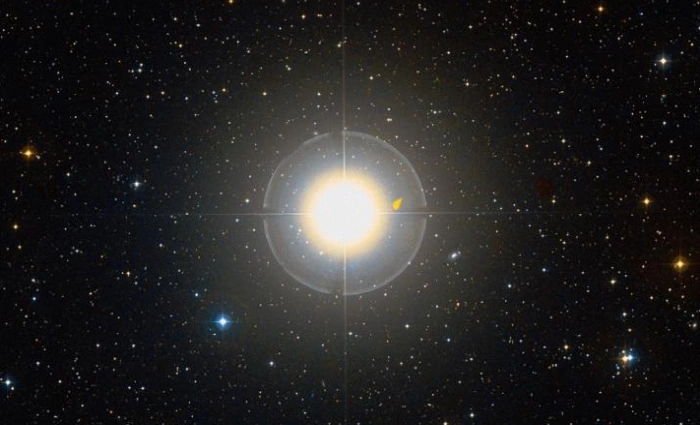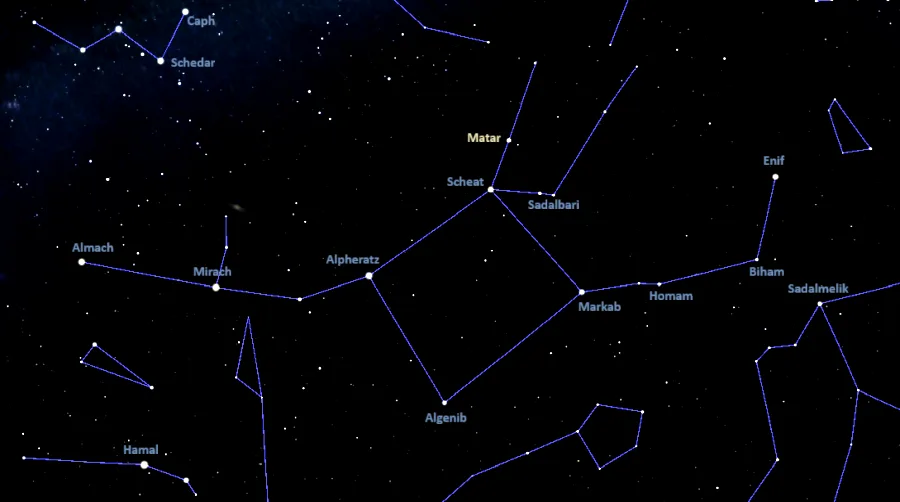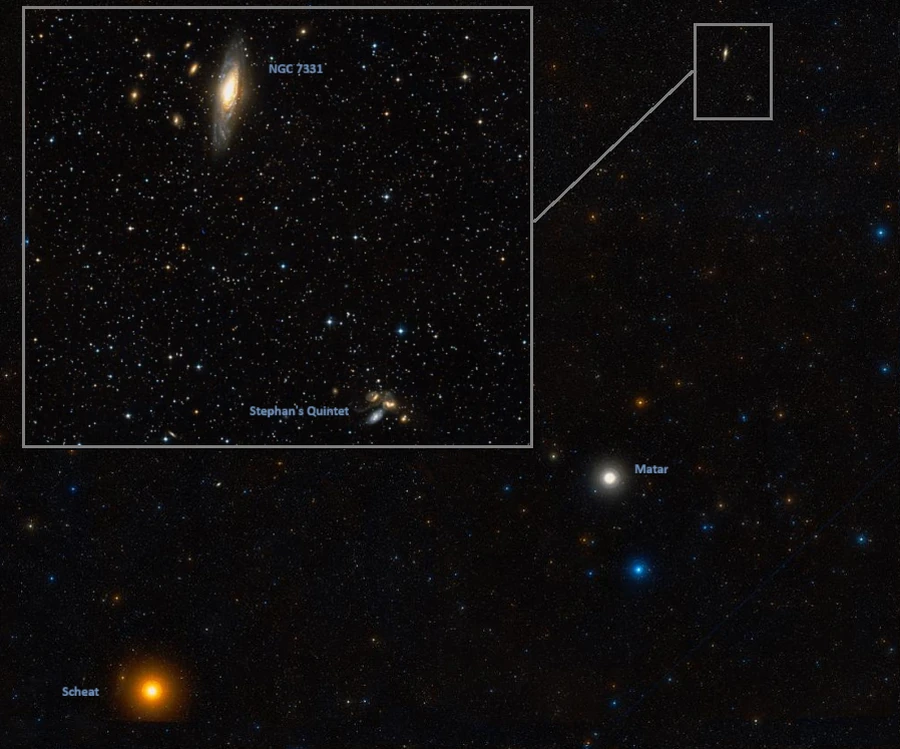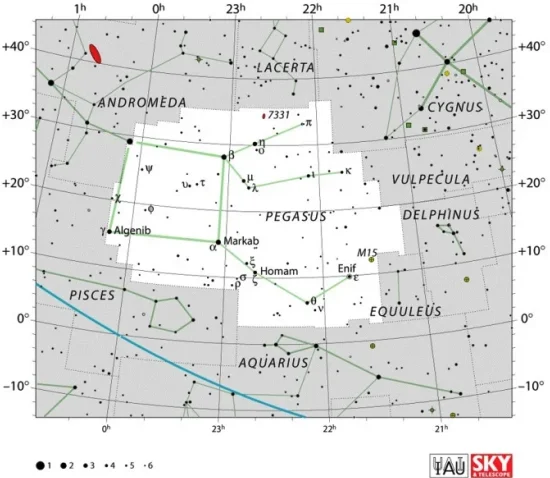Matar, Eta Pegasi (η Peg), is a binary star located at an approximate distance of 214 light years in the constellation Pegasus. With an apparent magnitude of 2.95, it is the fifth brightest star in Pegasus. It appears in the front leg of the celestial Winged Horse.
Star system
Eta Pegasi is a binary star system composed of a yellow bright giant of the spectral type G2 II and a white main sequence star with the stellar classification F0 V. The two components have an orbital period of 813 days.
The primary component, Eta Pegasi A, is formally known as Matar. The evolved star has a mass of 3.51 solar masses and a radius 24.51 times that of the Sun. With an effective temperature of 4,970 K, it is 330.8 times more luminous than the Sun. It has an estimated age of 270 million years.
Matar is a slow spinner. With a projected rotational velocity of 1.4 km/s, it takes 818 days to complete a rotation. The star is moving away from the solar system with a radial velocity of +4.17 km/s.

Matar (Eta Pegasi), image credit: ESO/Digitized Sky Survey 2 (CC BY 4.0)
Facts
Shining at magnitude 2.95, Matar is, on average, the 161st brightest star in the sky. It is only slightly fainter than Alniyat (Sigma Scorpii) in the constellation Scorpius, Sadalsuud (Beta Aquarii) in Aquarius, and Gamma Persei in Perseus. It is about as bright as Upsilon Carinae in Carina, Tau Puppis in Puppis, Algorab (Delta Corvi) in Corvus, Sadalmelik (Alpha Aquarii) in Aquarius, and Zaurak (Gamma Eridani) in Eridanus. It just outshines Tianguan (Zeta Tauri) in Taurus, Epsilon Leonis in Leo, and Alnasl (Gamma2 Sagittarii) in Sagittarius.
In old Chinese astronomy, Eta Pegasi was known as 離宮四 (Lì Gōng sì), the Fourth Star of Resting Palace. It formed the Resting Palace asterism with Lambda Pegasi, Sadalbari (Mu Pegasi), Omicron Pegasi, Salm (Tau Pegasi), and Nu Pegasi. The asterism was part of the larger Encampment mansion, one of the northern mansions of the Black Tortoise. It represented an imperial palace.
Name
The name Matar (pronunciation: /ˈmeɪtɑːr/) comes from the Arabic phrase Saʽd al Maṭar (Al Sad al Matar), meaning “the lucky star of rain.” In Arabic, al-matar means “the rain.” The name originally referred to Zeta and Omicron Pegasi.
The International Astronomical Union’s (IAU) Working Group on Star Names (WGSN) approved the name Matar for Eta Pegasi on August 21, 2016. The name formally applies only to the primary component, Eta Pegasi A, but has historically been used for the whole star system.
Location
Matar is easy to find because it lies near the Great Square of Pegasus, one of the brightest and largest asterisms in the northern celestial hemisphere. The star appears just northwest of Scheat (Beta Pegasi) at the northwestern corner of the Great Square.

Matar location, image: Stellarium
Matar can be used to find the bright spiral galaxy NGC 7331 with the Deer Lick Group of galaxies and Stephan’s Quintet, the most famous compact galaxy group in the sky. NGC 7331 appears around 4.4 degrees north of Matar, and Stephan’s Quintet lies just south of NGC 7331 and appears in the same wide field of view as the NGC 7331 Group.

Scheat, Matar, NGC 7331 and Stephan’s Quintet, image credit: ESO/Digitized Sky Survey 2 (CC BY 4.0)
Constellation
Matar is located in the northern constellation of Pegasus. The celestial Winged Horse is one of the ancient constellations, catalogued by the Greek astronomer Ptolemy of Alexandria in his Almagest in the 2nd century CE. In Greek mythology, it is associated with the flying horse Pegasus, the offspring of the god Poseidon and the Gorgon Medusa.
Pegasus is the seventh largest constellation in the sky and the third largest northern constellation, after Ursa Major and Hercules. It stretches across 1,121 square degrees of the sky just north of the celestial equator.
With its bright stars Algenib, Markab and Scheat forming the Great Square of Pegasus with Alpheratz in Andromeda, Pegasus is one of the most recognizable constellations in the sky. In the northern hemisphere, it dominates the evening sky throughout the autumn months. Alpheratz (Alpha Andromedae) used to be part of both Andromeda and Pegasus and had the Bayer designation Delta Pegasi before it was assigned exclusively to Andromeda.
The brightest star in Pegasus is Enif (Epsilon Pegasi), an orange supergiant with a visual magnitude of 2.399, located approximately 690 light-years away. The massive star is a supernova candidate. It marks Pegasus’ nose.
Other bright stars in the constellation include the evolved red star Scheat (Beta Pegasi), the white subgiant Markab (Alpha Pegasi), the massive blue subgiant Algenib (Gamma Pegasi), the hot blue main sequence star Homam (Zeta Pegasi), and the yellow giant Sadalbari (Mu Pegasi).

Pegasus constellation map by IAU and Sky&Telescope magazine (Roger Sinnott & Rick Fienberg) (CC BY 3.0)
Pegasus also hosts the giant star Alkarab (Upsilon Pegasi), the A-type star Biham (Theta Pegasi), the chemically peculiar star Salm (Tau Pegasi), the yellow and orange supergiants 9 and 12 Pegasi, the supernova candidate IK Pegasi, and the yellow dwarf Helvetios (51 Pegasi), the first main sequence star discovered to have an orbiting planet.
Pegasus contains several famous deep sky objects. These include the bright globular cluster M15 (the Great Pegasus Cluster), the Superman Galaxy (or Propeller Galaxy, NGC 7479), the compact galaxy group called Stephan’s Quintet, the gravitationally lensed quasar known as the Einstein Cross, the Fried Egg Galaxy (NGC 7742), and the bright spiral galaxy NGC 7331 with the Deer Lick Group of galaxies.
The constellation is also home to the spiral galaxy NGC 7217 and the interacting pairs of galaxies NGC 7752 and NGC 7753, and NGC 7469 and IC 5283.
The best time of the year to observe the stars and deep sky objects in Pegasus is during the month of October, when the constellation appears higher above the horizon in the early evening. The entire constellation is visible from locations north of the latitude 60° S.
The 10 brightest stars in Pegasus are Enif (Epsilon Peg, mag. 2.399), Scheat (Beta Peg, mag. 2.42), Markab (Alpha Peg, mag. 2.48), Algenib (Gamma Peg, mag. 2.84), Matar (Eta Peg, mag. 2.95), Homam (Zeta Peg, mag. 3.414), Sadalbari (Mu Peg, mag. 3.514), Biham (Theta Peg, mag. 3.52), Iota Pegasi (mag. 3.77), and Lambda Pegasi (mag. 3.93).
Matar – Eta Pegasi
| Spectral class | G2 II + F0 V |
| U-B colour index | +0.57 |
| B-V colour index | +0.86 |
| Apparent magnitude | 2.95 |
| Absolute magnitude | -1.1 |
| Distance | 214 ± 10 light-years (66 ± 3 parsecs) |
| Parallax | 16.6308 ± 0.7047 mas |
| Radial velocity | +4.17 ± 0.35 km/s |
| Proper motion | RA: +19.957 ± 0.496 mas/yr |
| Dec.: -18.971 ± 0.869 mas/yr | |
| Mass | 3.51 ± 0.13 M☉ |
| Luminosity | 330.8 ± 35.0 L☉ |
| Radius | 24.51 R☉ (23.3 – 25.62 R☉) |
| Temperature | 4,970 ± 65 K |
| Metallicity | +0.39 dex |
| Age | 0.27 ± 0.03 billion years |
| Rotational velocity | 1.4 km/s |
| Rotation | 818 days |
| Surface gravity | 2.40 cgs |
| Constellation | Pegasus |
| Right ascension | 22h 43m 00.1288449480s |
| Declination | +30° 13′ 16.372969392″ |
| Names and designations | Matar, Eta Pegasi, Eta Peg, η Pegasi, η Peg, 44 Pegasi, 44 Peg, HD 215182, HR 8650, HIP 112158, SAO 90734, FK5 857, BD+29°4741, AG+29 2819, GC 31706, GCRV 14271, PPM 88121, BLA 11, CSI+29 4741 1, SKY# 43181, NSV 14285, PMC 90-93 603, RAFGL 2938, ROT 3312, GEN# +1.00215182, GSC 02736-01823, PLX 5503.00, IRC +30499, JP11 3531, SBC7 926, SBC9 1396, SRS 30857, TD1 29299, TIC 10662523, UBV 19446, UBV M 26577, IRAS 22406+2957, 2MASS J22430012+3013165, TYC 2736-1823-1, N30 5002, WEB 20017, Gaia DR2 1887953690724601984, Gaia DR3 1887953690728237568, BU 1144A, FYM 145A, ADS 16211 A, CCDM J22430+3014A, IDS 22383+2942, WDS J22430+3013Aa,Ab |